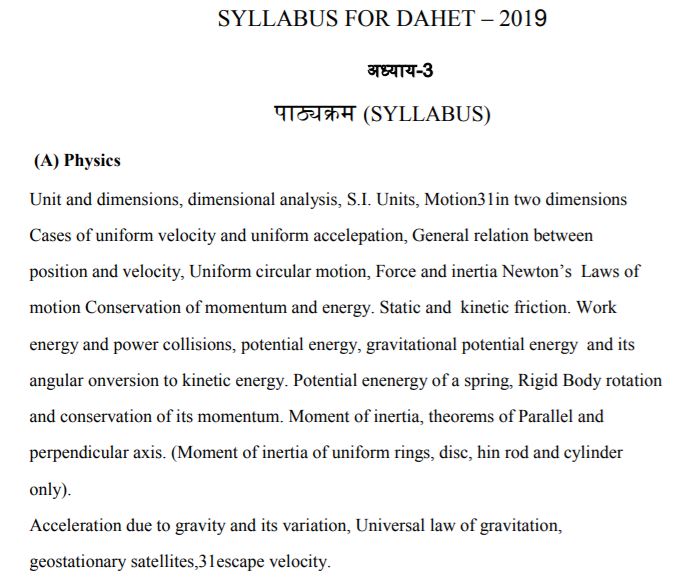MP Vyapam DAHET Syllabus 2021 PDF | Download Now @ peb.mp.gov.in: The Madhya Pradesh Professional Examination Board (MP Vyapam) officials have released the MP Vyapam DAHET Syllabus 2021 at the official website – peb.mp.gov.in. The Diploma in Animal Husbandry Entrance Test-2021 (DAHET) will be conducted soon. For the sake of candidates, We have inserted the direct download link for downloading MP Vyapam DAHET Syllabus 2021. Apart from this, we have also attached the Exam pattern Here.
MP Vyapam DAHET Syllabus 2021 – Overview

| Organization | MP Vyapam – Madhya Pradesh Professional Examination Board (MPPEB) |
| Post Name | Diploma in Animal Husbandry Entrance Test-2021 (DAHET) |
| Category | Syllabus |
| Exam Date | Announced Soon |
| Status | Available |
| Job Location | Madhya Pradesh |
| Official website | peb.mp.gov.in |
MP Vyapam DAHET Exam Pattern 2021
| Subject Name | Questions | Marks |
| Physics | 40 | 40 |
| Chemistry | 40 | 40 |
| General Studies | 20 | 20 |
| Total | 100 Questions | 100 Marks |
MP Vyapam DAHET Syllabus 2021
(A) Physics:
Unit and dimensions, dimensional analysis, S.I. Units, Motion31in two dimensions Cases of uniform velocity and uniform acceleration, General relation between position and velocity, Uniform circular motion, Force and inertia Newton’s Laws of motion Conservation of momentum and energy. Static and kinetic friction. Work energy and power collisions, potential energy, gravitational potential energy, and its angular conversion to kinetic energy. The potential energy of a spring, Rigid Body rotation, and conservation of its momentum. Moment of inertia, theorems of Parallel and perpendicular axis. (Moment of inertia of uniform rings, disc, hin rod, and cylinder only).
Acceleration due to gravity and its variation, Universal law of gravitation, geostationary satellites,31escape velocity. Hooke’s law, Young’s modulus shear, and bulk modulus, surface energy and surface tension, kinetic theory of gases, gas laws, kinetic energy, and temperature. Specific heats at constant volume and constant pressure, mechanical equivalent of heat, isothermal and adiabatic processes. Heat conduction in one dimension, convection and radiation,31 Stefan’s Law and Newton’s law of cooling, Periodic motion, simple harmonic motion, Oscillations due to spring, Wave motion, the principle of superposition; Processive and stationary waves, Beats and Doppler effect.
(B) Chemistry:
General and Physical Chemistry:
- Structure of Atom: Constitution of the nucleus: Bohr’s atom model: quantum numbers Aufbau principle, electronic configuration of elements (upto-Kr): de-Broglie relation, shapes of orbitals. Chemical Bond: Electrovalent, covalent and coordinate bonds, hybridization (sp): hydrogen bond: shapes of molecules (VSERR theory): bond polarity, resonance, Elements of VBT MOT. Solutions: Modes of expressing concentrations of solutions: Types of solutions
Inorganic Chemistry:
- Principles of metallurgical operations: Furnaces, ore concentration, extraction, purification metallurgies of Na, Al, Fe, Cu, Ag, Zn, and Pb, and their properties. Chemical periodicity. s, p, d, and f-block elements, Periodic Table: periodicity: atomic and ionic radii valency, ionization energy, electron affinity electronegativity, metallic character.
Comparative study of elements: Comparative study of the following families of elements: (i) alkali metals (ii) Alkaline earth metals (iii) Nitrogen family (iv) Oxygen family (v) Halogens (vi)Noble gases. Transition metals: Electronic configuration of 3d-metal ions, oxidation states, other general characteristic properties, Potassium permanganate, Potassium dichromate. Co-ordination compounds: Simple nomenclature, bonding, and stability, Classification and bonding in organometallics. Chemical analysis: The chemistry involved is simple inorganic qualitative analysis: calculations based on acid-base titrimetry.
Organic Chemistry :
- Calculation of empirical and molecular formula of organic compounds, Nomenclature of organic compounds common functional groups isomerism structure and shapes of alkanes and benzene. Preparation properties and uses of alkynes, alkyl, benzene, petroleum, cracking octane number, gasoline additives. Nomenclature, Physical-chemical properties, correlation of physical properties with structure properties and uses of haloalkanes, halobenzene’s, alcohols and phenols: General ideas of some polyhalogeno compounds viz., dichlorophenes, dichloroethane, chloroform, carbon tetrachloride D.D.T., benzene hexachloride. Nomenclature, methods of preparation, Chemical properties, correlations of physical properties with structure and uses of ethers, aldehydes, ketones, carboxylic acids, and their derivatives. A brief account of the chemistry of cyanides, isocyanides, amines, and nitrogen compounds. Polymers: Classification: Preparation and uses of common natural and synthetic polymers. Biomolecules: Classification, Structure, and biological importance of carbohydrates, amino acids, peptides, proteins and enzymes, nucleic acids, and lipids.
C. General Studies (20 Question):
1. General Science and Environment
2. Geography, History, Sport and Culture of M.P.
3. Information and Communication Technology

